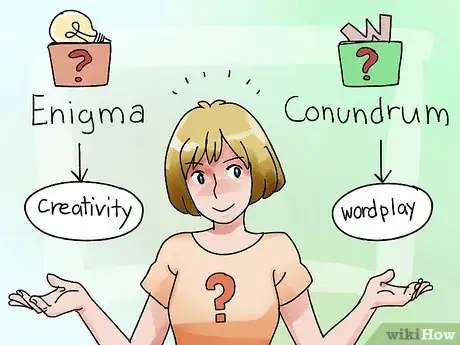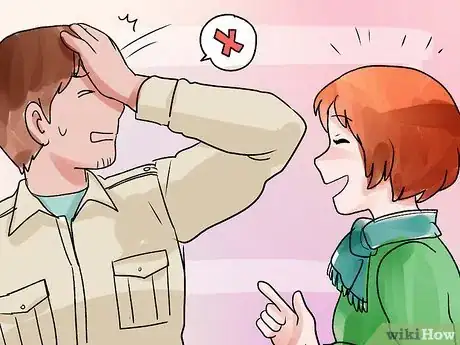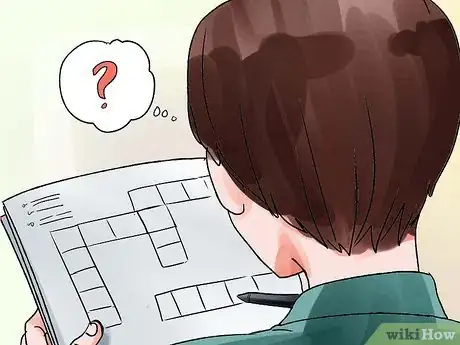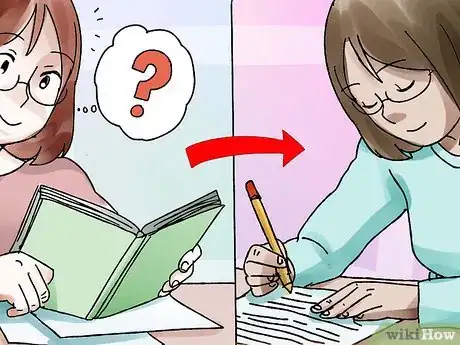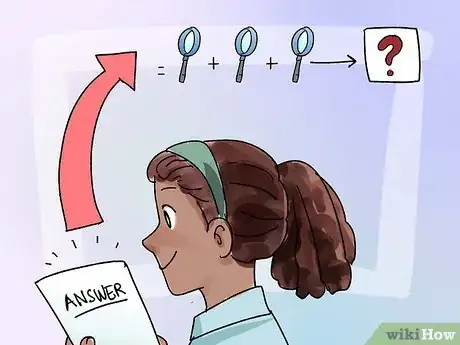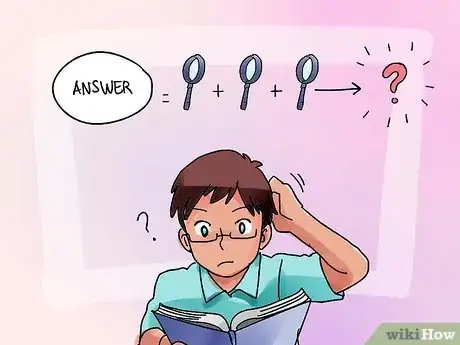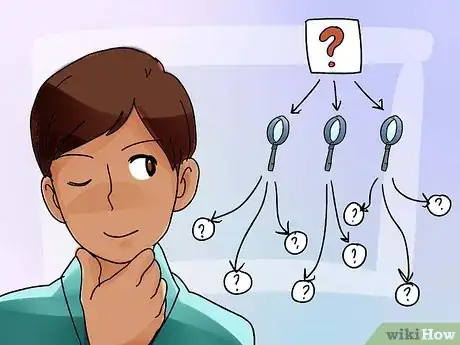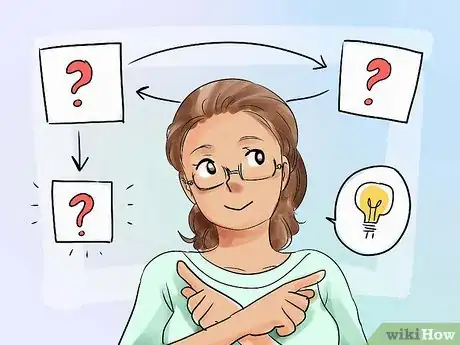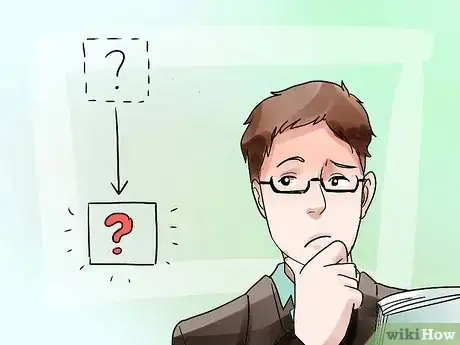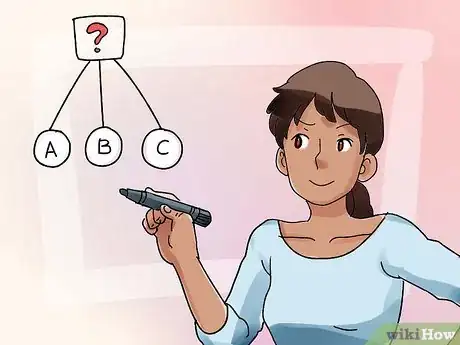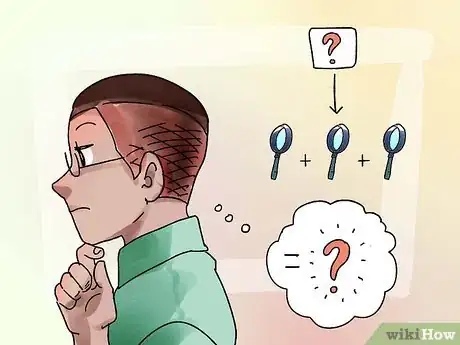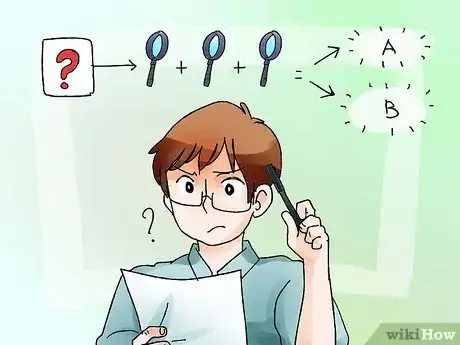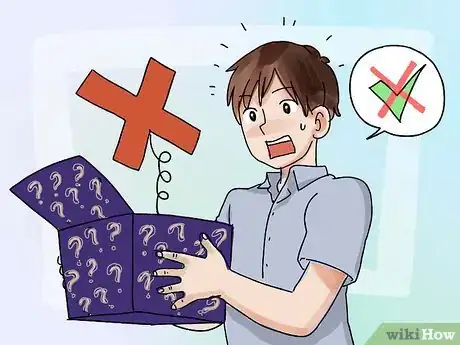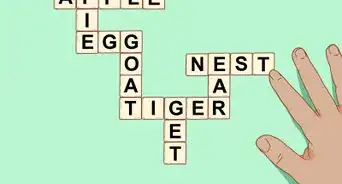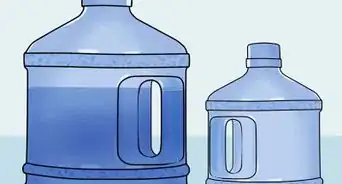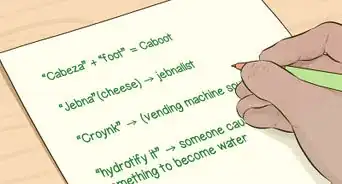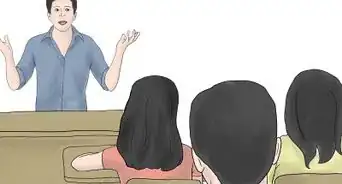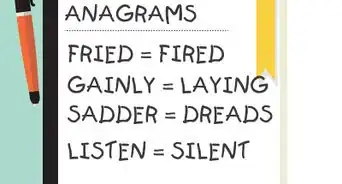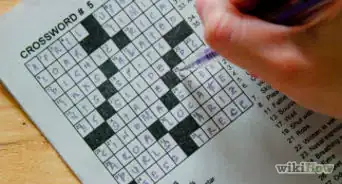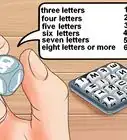wikiHow is a “wiki,” similar to Wikipedia, which means that many of our articles are co-written by multiple authors. To create this article, 11 people, some anonymous, worked to edit and improve it over time.
There are 9 references cited in this article, which can be found at the bottom of the page.
This article has been viewed 240,112 times.
Learn more...
Riddles can help sharpen the mind and open up new thought processes. Practicing riddles each day can help simplify thinking, provide better memory retention and improve cognitive capabilities. Even challenging riddles can be solved if you use a few simple techniques.
Steps
Learning How Riddles Work
-
1Know the basic types of riddles. There are two basic types of riddles: enigmas and conundrums. Both are often framed as a dialogue between the riddle asker (often the riddle’s solution) and the riddle answerer.
- Enigmas are posed as problems using metaphorical, allegorical, or associational language that require creativity and experience to answer. For example: “If the sun sets, a flower-garden; but if you look at it after dawn, an empty garden. What is it?” (Answer: the sky.)[1]
- Conundrums are posed as questions that incorporate puns in the question, the answer, or both. For example: “What flowers can be found between the nose and chin?” (Answer: Tulips/”Two lips”)[2]
-
2Understand the rules of riddles. Most riddles deal with very familiar topics. Their difficulty comes in how those topics are described. Riddles often create a pattern of associations in order to direct you to the answer.
- For example, a popular riddle from J.R.R. Tolkien’s The Hobbit goes: “Thirty white horses on a red hill, / First they champ, / Then they stamp, / Then they stand still.”[3] This riddle uses familiar ideas (horses, hills) to figuratively express the answer (in this case, “teeth.”)
Advertisement -
3Know that riddles might attempt to confuse you. Seemingly logical associations may really be misdirection. The correct answer may be so obvious that you initially dismiss it.
- Red herrings are a common form of misdirection through association, as seen in this riddle: “A green man lives in the green house. A blue man lives in the blue house. A red man lives in the red house. Who lives in the white house?” The immediate answer, given the pattern set up, would be “a white man,” but the “White House” is a red herring: the President of the United States lives in the White House!
- A traditional African riddle asks: “How do you eat an elephant?” (Answer: one bite at a time.) This riddle is a good example of an answer being hidden in plain sight.
- Other “riddles” are not true riddles at all. For example, this traditional Yiddish riddle asks: “What hangs on a wall, is green, wet, and whistles?” The answer is “a herring” because you can hang a herring on a wall and paint a herring green. If the herring has been freshly painted, it is wet. The joke is that it really doesn’t whistle -- there’s intentionally no solution to this riddle.[4]
Sharpening Your Analytical Skills
-
1Solve puzzles daily. Solving puzzles requires you to combine what you already know with new information from the puzzle. Just like riddles, puzzles ask you to use existing knowledge and context clues to come up with an original, often tricky answer.[5] Puzzles can help you learn to recognize patterns and order.[6]
- Puzzle games such as Tetris, as well as traditional jigsaw puzzles, require you to look at a situation in multiple ways to figure out the best solution. This process transfers well into solving riddles, too.
- Specific types of puzzles and games are best at developing specific types of skills. Though, if you do a lot of crossword puzzles, you’ll probably get very good at crossword puzzles, but you may not see equivalent gains in other areas. It’s helpful to play a variety of games instead of focusing on only one type.[7]
-
2Alternate your brain games regularly. The more you repeat a certain type of task, the less effort your brain needs to expend to perform it. Regularly alternating the types of games you play will help keep your brain from taking shortcuts.[8]
-
3Try reading and then summarizing something complex. For example, you could read a complex news story and then write a short summary that boils down all the ideas into a few key ideas. Research suggests that this will help you look at the “big picture” as well as the details, a skill that also comes in handy when solving riddles.[9]
- Rephrasing ideas into your own words may also help you develop linguistic flexibility and improve memory. It’s easier to remember ideas when you’ve taken the time to paraphrase them, because your brain has had to work to structure the ideas so that it understands them.
Practicing on Riddles You Know
-
1Reverse-engineer some famous riddles. You may find it helpful to start with some riddles for which you already know the answer. There are many collections of riddles online and in books that you can use to practice on.
-
2Work backwards from the solution and try to figure out how the riddle works. Riddles tend to assume that the answer should already be known; part of the fun of a riddle is seeing whether you can stump someone by asking them about something they don’t know that they know. Although the wording itself may be tricky, the solution is usually something familiar.
- For example, a famous enigma in Sophocles’ play Oedipus the King asks, “What goes on four feet in the morning, two feet at noon, and three feet in the evening?” The answer is “a person”: a baby crawls when it is young (morning), walks upright when it is an adult (noon), and has to use a cane when it is old (evening).[10]
-
3Start by breaking down the riddle into parts. With the Oedipus enigma, a good place to start might be the “feet,” since they’re repeated throughout the riddle. What has four feet? What has two feet? What has three feet?
- What has four feet? Many animals have four feet, so that’s a possible answer. Tables and chairs also have four feet, and they’re common things too, so keep those in mind.
- What has two feet? People seem an obvious choice here, since humans are familiar and they have two feet. Chairs and tables don’t have two feet, so they’re probably not the answer.
- What has three feet? This is the tricky part. Animals don’t usually have three feet unless one has been taken away. However, if the animal started with four feet and then went to two feet, it wouldn’t re-grow a third foot. That means that we’re probably looking at the third foot as a kind of tool: something that has been added.
- What uses tools? A person is the most familiar answer, so this might be the target.
-
4Think about the actions in the riddle. We only get one verb in this enigma, “goes.” So we know whatever the solution is, it’s capable of going somewhere.
- This might mean that it goes because something else makes it go (like a car), so don’t make up your mind just yet. Maintaining an open mind is crucial for solving riddles.
-
5Consider any other information in the riddle. The other information in the Oedipus enigma is the problem of time. The riddle gives you “morning,” “noon,” and “evening” as the times when the actions happen.
- Because the riddle begins in the morning and ends in the evening, it seems likely that the riddle is asking about something that happens across the progress of time from beginning to end.
- Be careful to avoid over-literal thinking when considering riddles. They are almost always figurative; “noon” might not mean “12:00 PM” so much as the “middle” of something.
-
6Combine the actions in the riddle with your potential solutions. Now you can begin narrowing down the possible solutions by eliminating what you know doesn’t work.
- Chairs and tables can’t “go” on their own feet. That makes them unlikely solutions.
- A person has multiple feet, they can “add” more feet by using tools like canes and crutches, and they can “go” somewhere on their feet. Even if you don’t quite know how the feet work together with time yet, “person” seems like a solid solution.
Solving Riddles
-
1Determine what type of riddle you’re working with. Some riddles require creative math skills, such as this riddle: “A barrel of water weighs 50 pounds. What must you add to it to make it weigh 35 pounds?” (Answer: a hole.)
- Although both enigmas and conundrums often ask the riddle in the form of a question, enigmas are often more complex problems, while conundrums may ask a simple question.
-
2Consider the possibilities. With a challenging riddle, it may be helpful to break down the riddle into parts, as demonstrated in Part 2.
- While breaking down a riddle into parts and considering multiple possible solutions may seem awkward or clunky at first, it will get much faster and easier with practice.
-
3Suspend judgment on the answer. One of the most important tactics when listening to or reading a riddle is to not jump to conclusions. To solve a riddle, you will need to consider both the literal and the potential meanings of the words.
- For example, this riddle asks: “What gets wetter and wetter the more it dries?” (Answer: a towel.) Even though the actions seem contradictory, a towel does dry things and get wet as it dries those things.
-
4Practice flexibility in considering answers. Try to think of different ways to interpret the clues the riddle gives. Enigmas in particular are often very figurative, meaning they will use words with a literal meaning to convey something metaphorical.
- For example, this riddle asks: “What has golden hair and stands in the corner?” The answer is a broom: the “golden hair” is the yellow straw of a traditional straw broom, and it “stands” in the corner when it isn’t being used.
-
5Understand that sometimes riddles will try to trick you. This is particularly common with riddles that are written to sound like they are asking for an inappropriate or explicit answer. The possibility of multiple answers allows for a laugh from both parties.
- The goal of a trick riddle is to get you to give the most “obvious” (and also usually most explicit) answer. For example, there are several answers to this riddle: “What four-letter word ending in K means ‘intercourse’?” In order to give the “right” answer (“talk”), you must look past the most common assumptions and think more flexibly.
Community Q&A
-
QuestionWhat is at the beginning of eternity and the end of time, is in every race, but is always last in line?
 Community AnswerThe letter E. It's the first letter in "eternity," the last letter in "time," an essential letter in "race," and the last letter in "line."
Community AnswerThe letter E. It's the first letter in "eternity," the last letter in "time," an essential letter in "race," and the last letter in "line." -
QuestionCould you solve this riddle for me: Green jacket on the outside, white jacket as the second layer and a red jacket to finish. Inside I am pregnant with a lot of babies -- what am I?
 Community AnswerA watermelon. It can also sometimes be stated as: There is a greenhouse. Inside the greenhouse there is a white house. Inside the white house is a red house. Inside the red house are many babies. What am I?
Community AnswerA watermelon. It can also sometimes be stated as: There is a greenhouse. Inside the greenhouse there is a white house. Inside the white house is a red house. Inside the red house are many babies. What am I? -
QuestionI have one letter. But my name is spelled with eight, what is the answer to this riddle?
 Community AnswerEnvelope. An envelope contains a single letter, but the word is spelled with eight letters.
Community AnswerEnvelope. An envelope contains a single letter, but the word is spelled with eight letters.
References
- ↑ http://nirc.nanzan-u.ac.jp/nfile/1820
- ↑ http://archive.org/stream/conundrumsriddle00rive/conundrumsriddle00rive_djvu.txt
- ↑ http://tolkien.cro.net/talesong/riddles.html
- ↑ https://books.google.com/books?id=V04IRE3SwmgC&lpg=PR23&ots=orpno6BqzE&dq=joys%20of%20yiddish%20herring&pg=PR23#v=onepage&q=joys%20of%20yiddish%20herring&f=false
- ↑ http://www.psychologytoday.com/blog/brain-workout/200904/puzzles-and-the-brain
- ↑ http://discovermagazine.com/2009/the-brain/24-which-brain-games-will-help-you-the-most
- ↑ http://www.psychologytoday.com/blog/make-your-brain-smarter/201403/do-brain-games-really-boost-brainpower
- ↑ http://time.com/3423009/brain-games-keep-my-mind-sharp/
- ↑ http://www.psychologytoday.com/blog/make-your-brain-smarter/201403/do-brain-games-really-boost-brainpower
About This Article
To solve a riddle, start by identifying whether the riddle is a conundrum, which is usually a simple question that uses puns, or an enigma, which is more complex and metaphorical. Then, break the riddle down into parts and consider possible solutions for each part. As you try to solve the riddle, avoid jumping to conclusions. Instead, think about both the literal and figurative meaning of the words in the question. If the riddle seems to have an obvious, but inappropriate answer, it’s probably trying to trick you, so think flexibly and look past the obvious. For tips on how to sharpen your analytical skills so you can solve riddles quickly, read on!
